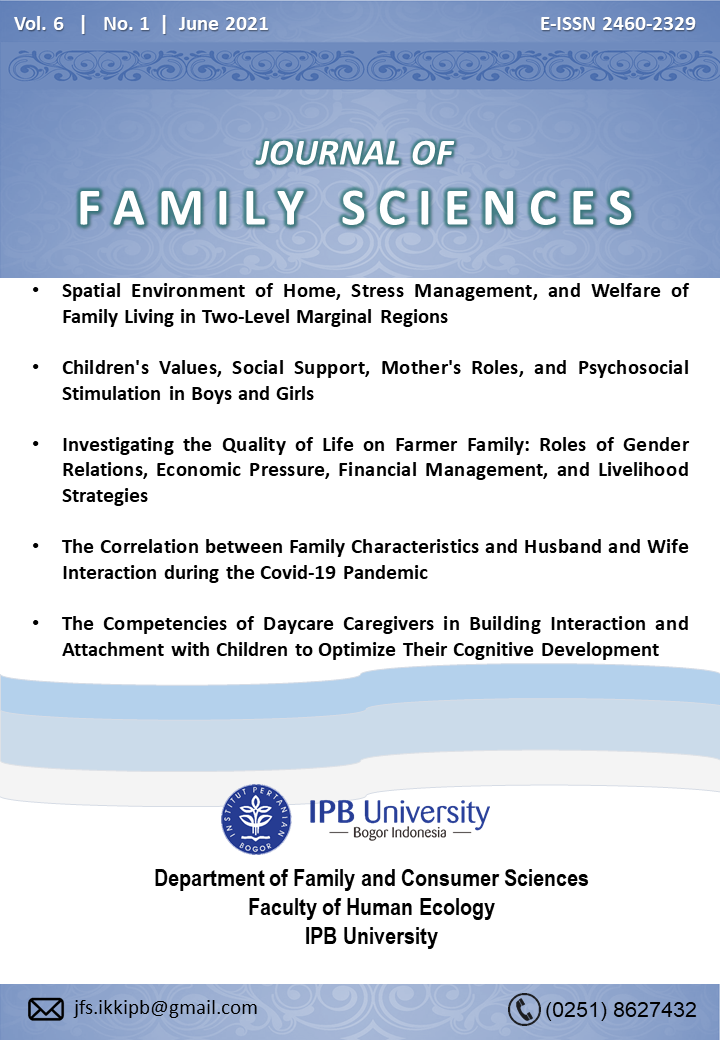Spatial Environment of Home, Stress Management, and Welfare of Family Living in Two-Level Marginal Regions
Abstract
This study aims to analyze the home environment, stress management, and families' welfare in marginal areas. The study design was cross-sectional, and samples were selected by random cluster sampling, as many as 126 families consisting of 63 families from the very dense region (VDR> 200 people per Ha) and 63 families from a rather dense region (RDR, 121-160 people per Ha) in Bogor, West Java, Indonesia. The data were collected by interview using a questionnaire in March and April 2014 and analyzed using descriptive and comparison tests. The analysis showed that families in RDR had a lower density but had a higher crowd level than in VDR, so that families in RDR had to try harder to get non-physical privacy. RDR families had a higher source of stress, thus encouraging them to did more coping strategies. The analysis showed that families in RDR had higher objective well-being but lowered subjective welfare than families in VDR. Families in RDR had higher physical welfare and lowered social and psychological welfare than families in VDR. The research findings had implications for the importance of strengthening the family environment and developing research methodologies in the field of family ecology.
Downloads
References
Alatartseva, E., & Barysheva, G. (2015). Well-being: Subjective and objective aspects. Procedia – Social and Behavioral Sciences, 166, 36-42. Doi: https://doi.org/10.1016/j.sbspro.2014.12.479
Anjanie, F. F. (2006). Pengaruh kepadatan terhadap interaksi sosial warga rumah susun apron Kemayoran (The influence density on social interaction of Kemayoran apron flats residents) (Undergraduate theses, Bogor Agricultural University, Indonesia). Retrieved from http://repository.ipb.ac.id/jspui/bitstream/123456789/50999/1/A06ffa1.pdf
Baquyatan, S. M. (2015). The impact of housing issue on the well-being of middle-income group. Mediterranian Journal of Social Sciences, 6(6 S1), 522-527. Doi: http://dx.doi.org/10.5901/mjss.2015.v6n6s1p522
Bonnefoy, X. (2007). Inadequate housing and health: An overview. International Journal Environment and Pollution. 30(3-4), 411-429.
BPS Kota Bogor. (2014). Jumlah dan persentase penduduk miskin, garis kemiskinan, indeks kedalaman kemiskinan, dan indeks keparahan kemiskinan menurut provinsi September 2013 (Number and percentage of poor people by province). Retrieved from http://www.bps.go.id/tabel_excel/indo_23_1.xls.
Chan, Y. (1999). Density, crowding, and factors intervening in their relationship: Evidence from a hyper-dense metropolis. Social Indicators Research, 48(1), 103-124. Retrieved from http://www.jstor.org/stable/27522404
Diener, E. (1984). Subjective well-being. Psychological Bulletin, 95(3), 542-575. Doi: http://dx.doi.org/10.1037/0033-2909.95.3.542
Elder, G., Conger, R., Foster, E., & Ardelt, M. (1992). Families under economic pressure. Journal of Family Issues, 13(1), 5-37. https://doi.org/10.1177/019251392013001002
Ezeh, A., Oyebode, O., Satterthwaite, D., Chen, Y.F., Ndugwa, R., Sartori, Jo., Mberu, B., Melendez-Torres, G. J., Haregu, T., Watson, S. I., Caiaffa, W., Capon, A., & Lilford, R. (2017). The history, geography, and sociology of slums and the health problems of people who live in slums. The Lancet 389 (10068), 547-558. Doi: http://dx.doi.org/10.1016/S0140-6736(16)31650-6
Halim, D. K. (2008). Psikologi lingkungan perkotaan (Urban environment psychology). Jakarta, Indonesia: Bumi Aksara.
Henley, P., Lowthers, M., Koren, G., Fedha, P. T., Russell, E. VanUmm, S., Arya, S., Darnell, R., Creed, I. F., Trick, C. G., & Bend, J. R. (2014). Cultural and socio-economic conditions as factors contributing to chronic stress in sub-Saharan African communities. Canadian Journal of Physiology and Pharmacology, 92, 725-732. Doi: http://dx.doi.org/10.1139/cjpp-2014-0035
Herlanti, Y., Sumarwan, U., & Uripi, V. (1995). Faktor-faktor yang mempengaruhi gejala fisik dan gejala jiwa stress pada ibu bekerja dan ibu tidak bekerja (Factors affecting the physical-mental symptoms of stress of mothers). Jurnal Media Gizi dan Keluarga, 18-26.
Iskandar, A. (2007). Analisis praktek manajemen sumberdaya keluarga dan dampaknya terhadap kesejahteraan keluarga di Kabupaten dan Kota Bogor (Analysis of family resource management practices and their impact on family well-being in the county and the city of Bogor). Sodality: Jurnal Transdisiplin Sosiologi, Komunikasi, dan Ekologi Manusia 1(3), 295-312. Doi: http://dx.doi.org/10.22500/sodality.v1i3.5924
Ivković A., Ham, M., & Mijoč, J. (2014). Measuring objective well-being and sustainable development management. Journal of Knowledge Management, Economics, and Information Technology, 4(2).
Jacinto, L.G., & Mendieta, H. (2002). Multiple effects of community and household crowding. Journal of Environment Psychology, 22(2), 233-246. Doi: https://doi.org/10.1006/jevp.2002.0236
Lirebo, D. (2006). Informal settlements in Addis Ababa. UDP-705 Housing in Urban Context (Addis Ababa University, Ethiopia). Retrieved from http://etd.aau.edu.et/bitstream/handle/123456789/496/Daniel%20Lirebo.pdf?sequence=1&isAllowed=y
Mansour, S., & Mostafa, M. M. (2018). Residential urban overcrowding in Alexandria, Egypt: A spatial econometrics analysis. African Journal of Business and Economic Research (AJBER), 13(1), 157-176.
Maryam, S. (2010). Pengaruh karakteristik sosial ekonomi terhadap strategi coping keluarga pasca gempa dan tsunami di Nanggroe Aceh Darussalam (The effects of socio-economic characteristics to coping strategy in family post-earthquake and tsunami in Nanggroe Aceh Darussalam). Jurnal Aplikasi Manajemen, 8(2), 546-560.
McCubbin, H. I., & Thompson, A. I. (1987). Family assessment inventories for research and practice. Madison, USA: The University of Wisconsin-Madison.
McMullen, J. G. (1992). Privacy, family autonomy, and the maltreated child. Marquette Law Review, (75)3, 569-598.
Melson, G. F. (1980). Family and environment: An ecosystem perspective. Minneapolis, USA: Burgess Publishing Company.
Milligan, S., Fabian, A., Coope, P., & Errington, C. (2006). Family well-being indicators from the 1981–2001 New Zealand censuses. New Zealand: Statistics New Zealand. Retrieved from http://archive.stats.govt.nz/~/media/Statistics/browse-categories/people-and-communities/families/family-wellbeing/family-wellbeing-report-2006.pdf
Mirrowsky, J., & Ross, C. E. (1989). Social causes of psychological distress. New York, USA: Aldine de Gryuter.
Morimoto, H., Shimada, H., & Ozaki, K. (2013). Does stressor evaluation mediate sociocultural influence on coping selection? An investigation using Japanese employees. International Journal of Stress Management, 20(1), 1-19. Doi: http://dx.doi.org/10.1037/a0031432
Nagasawa, N., Yamaguchi, R., Kato, R., Tanabe, S. (2018). Longitudinal study of housing for the promotion of health and well-being using a covariance structure model to identify the causal relationships between satisfaction with living environment, stress, and chronic low back pain. Japan Architectural Review, 1(1), 154-166. Doi: https://doi.org/10.1002/2475-8876.10018
Nkosi, V., Haman, T., Naicker, N., & Mathee, A. (2019). Overcrowding and health in two impoverished suburbs of Johannesburg, South Africa. BMC Public Health, 19(1). Doi: https://doi.org/10.1186/s12889-019-7665-5
Ozkan, S., & Kutlu, Y. (2010). Evaluation of coping strategy, social support, and depressive symptoms in spouse of patients with hematological cancer. Turk J Med Sci, 40(6), 925-936. Doi: 10.3906/sag-0904-6
Pestonjee, D. M., & Pandey, S. (2013). Stress and work, perspectives on undertstanding and managing stress. California, USA: SAGE Publications Inc.
Poedjioetami, E. (2005). Lokasi strategis sebagai potensi ketahanan hidup di permukiman marjinal: Studi kasus permukiman sepanjang rel kereta api (KA) dari lintasan Jalan Bung Tomo – Jalan Jagir Wonokromo Surabaya (Strategic location as survival potential at marginal settlements: Case Study by the railway-settlements Bung Tomo – Jagir Wonokromo Surabaya route). Jurnal Rekayasa Perencanaan, 2(1), 28-41.
Rani, D., Singh, J. K., Acharya, D., Paudel, R., Lee, K., & Singh, S. P. (2018). Household food insecurity and mental health among teenage girls living in urban slums in Varanasi, India: A cross-sectional study. International Journal of Environmental Research and Public Health, 15 (8), 1585. Doi: https://doi.org/10.3390/ijerph15081585
Razali, N., & Talib, A. (2013). Aspect of privacy in muslim Malay Traditional dwelling interior in Melaka. Procedia – Social and Behavioral Sciences. 105, 664-66. Doi: https://doi.org/10.1016/j.sbspro.2013.11.067
Rosino, M. (2016). ABC-X model of family stress and coping. The Wiley Blackwell Encyclopedia of Family Studies. New Jersey, USA: John Wiley & Sons, Inc. Doi: https://doi.org/10.1002/9781119085621.wbefs313
Santrock, J. W. (2007). Perkembangan anak Edisi ke 11 Jilid 2 (Child development) (2nded.). Jakarta, Indonesia: Erlangga.
Sarracino, F. (2008). Subjective well-being in low income countries; positional, relational and social capital components. Studi e Note in Economia. 13(3), 449-477.
Sarwono, S. W. (1992). Psikologi lingkungan (Environmental psychology). Jakarta, Indonesia: Grasindo.
Singh, C., Sharma, S., & Sharma, R. (2011). Level of stress and coping strategies by nursing interns. Nursing and Midwifery Research Journal, 7, 152-160. Doi: 10.12816/0032673
Stokols, D. (1972). On the distinction between density and crowding: Some implications for future research. Psychological Review, 79(3), 275-277. Doi: http://dx.doi.org/10.1037/h0032706
Suandi. (2007). Modal sosial dan kesejahteraan ekonomi keluarga di daerah pedesaan dan provinsi Jambi (Social capital and economic welfare of families in rural areas of Jambi provinces) (Doctoral theses, Bogor Agricultural University, Indonesia). Retrieved from https://repository.ipb.ac.id/handle/123456789/40884
Subbaraman, R., Nolan, L., Shitole, T., Sawant, K., Shitole, S., Sood, K., Nanarkar, M., Ghannam, J., Betancourt, T. S., Bloom, D. E., & Patil-Deshmukh, A. (2014). The psychological toll of slum living in Mumbai, India: A mixed-methods study. Social Science & Medicine, 119; 155-169. Doi: http://dx.doi.org/10.1016/j.socscimed.2014.08.021
Sunarti, E. (2012). Keragaan ketahanan keluarga Indonesia: Pembangkitan teori (Middle Range Theory) dan rumusan kebijakan ketahanan keluarga Indonesia (Family strength of Indonesian family emerging Middle Range Theory and formulating the family policy). Hibah Kompetensi DP2M Dikti Research Report.
Sunarti, E. (2013a). Work Stability, economic pressure, and family welfare in Indonesia. Paper Presented at 5th International Community Work and Family Conference, Sydney, Australia.
Sunarti, E. (2013b). Ketahanan keluarga (Family strength). Bogor, Indonesia: IPB Press.
Sunarti, E. (2019). The portrait of the value and management of family time. Pertanika Journal of Social Science & Humanities, 27(2), 993-1006.
Sunarti, E., & Junita, S. (2011). Pengelolaan stress pada keluarga korban bencana alam di Kabupaten Bogor. 120 (Stress management in family victims of natural disasters in Bogor). Jurnal Ilmu Keluarga dan Konsumen, 4(2), 111-120.
Sunarti, E., Fithriyah, A. F., & Ulfa, M. (2019). Family-friendly kampong (FFK) modelling: developing urban resilience in disaster-prone area. Equity, Equality, and Justice in Urban Houseing Development, KnE Social Sciences, 2019, 243-255. Doi: https://doi.org/10.18502/kss.v3i21.4972
Sunarti, E., Ifada, Q., Ika, D., & Sri, H. (2005). Ketahanan keluarga, manajemen stress, dan pemenuhan fungsi ekonomi dan fungsi sosialisasi keluarga korban kerusahan Aceh (Family strength, stress management, and compliance of economic and social of family affected by Aceh disaster). Media Gizi dan Keluarga, 29(1), 41-49.
Surtiani, E. (2006). Faktor–faktor yang mempengaruhi terciptanya kawasan pemukiman kumuh di kawasan pusat kota, studi kasus: kawasan Pancuran, Salatiga (Factors affecting the creation of slums areas in the city center region, case study: Kawasan Pancuran, Salatiga) (Masters theses, Universitas Diponegoro, Indonesia). Retrieved from http://eprints.undip.ac.id/15530/
UNDP. (2017). Happiness, well-being, and human development: The case for subjective measures. 2016 UNDP Human Development Report Background Paper. Retrieved from http://hdr.undp.org/sites/default/files/anand_template_rev.pdf
UNHabitat. (2016). Informal settlements. Habitat III Issue Papers 22. Retrieved from https://unhabitat.org/habitat-iii-issue-papers-22-informal-settlements/
WHO. (2003). People living in informal settlements. Retrieved from: http://www.who.int/ceh/indicators/informalsettlements.pdf
Zuhara, I., Muflikhati, I., & Krisnatuti, D. (2017). Stressor, social support, coping strategy, stress and life satisfaction of married woman student. Journal of Family Sciences, 2(1), 1-14.
Copyright (c) 2021 Journal of Family Sciences

This work is licensed under a Creative Commons Attribution 4.0 International License.
Authors who publish with this journal agree to the following terms:
- Authors retain copyright and grant the journal right of first publication with the work simultaneously licensed under

This work is licensed under a Creative Commons Attribution 4.0 International License. that allows others to share the work with an acknowledgement of the work's authorship and initial publication in this journal. - Authors are able to enter into separate, additional contractual arrangements for the non-exclusive distribution of the journal's published version of the work (e.g., post it to an institutional repository or publish it in a book), with an acknowledgement of its initial publication in this journal.
- Authors are permitted and encouraged to post their work online (e.g., in institutional repositories or on their website) prior to and during the submission process, as it can lead to productive exchanges, as well as earlier and greater citation of published work (See The Effect of Open Access).



_001.png)



